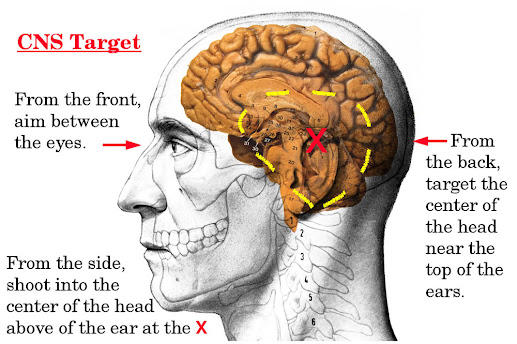The Consequences of Ignoring Declination in Land Navigation Can Kill You...
NOT TAKING LOCAL DECLINATION INTO ACCOUNT WHEN NAVIGATING COULD BE DISASTEROUS
Let's say, for discussion's sake, you’ve plotted on your map and then set a 78 MAZ on your compass and you haven't either adjusted your compass for the local declination or converted your grid azimuth to magnetic by either subtracting or adding the correct declination degrees, depending on where you are in the country. This oversight will cause a proportionate error when you start your navigation that only gets worse as you go along. Here's the error factor of being off by various degrees computed to distance from the target from exact, straight line navigation with no drift whatsoever:
•
1 degree of error at 1,000 meters from start
point = 17.5 meters off target (or 19 yards)
•
5 degrees of error at 1,000 meters from start
point = 87.5 meters off target (95 yards)
•
8 degrees of error at 1,000 meters (my AO) start
point = 140 meters off target (153 yards)
•
10 degrees of error at 1,000 meters start
point = 175 meters off target (191 yards)
•
16 degrees of error at 1,000 meters start
point = 280 meters off target (306 yards)
•
21 degrees of error at 1,000 meters start
point = 367.5 meters off target (401 yards)
We'll use the maximum variation in the US - 21 degrees East (Washington State) for a short, 3 click walk (just about 2 ¾ miles).
Another Drum roll: You’d be off your target by 1,102.5 meters/1,205 yards before you took a single pace! Over a click off your target from the get go in Washington State and drift, deviation, and pace count error haven't been factored in yet, let alone the soon to be fact that you are lost. If you're trying to get to a place with food, water, and friends, depending on the season, the weather might just kill you. If you're navigating through hostile territory, well, use your imagination.
Let’s back it down to the declination 7.5 degrees W, it comes out to 420 meters/459 yards - almost half a click - which is a LOT in a rural/wilderness, hostile weather, or hostile human environment.
Bottom line? Ignoring declination can get you killed. Always check your declination and ALWAYS either adjust your compass (if it's declination adjustable) or perform the addition or subtraction of the correct declination when going from the grid map to the magnetic compass.





I grew up with 0 dec. Learned terrain association anyway, found it led to better results (for me), with all the metal deposits in the ground.
ReplyDeleteNow live at 0°23' W dec, with The Iron Range just north, and find terrain association still works better (for me).
Best guess is majority of people will be screwed when GPS goes down because the only maps they've ever seen have a blinking dot on an electronic device, and have never tried to drive or walk anywhere without it, much less committed infrequent routes to memory.
Or have the capacity to do so.
DTG, thanks for the declination map, found my AO went from 13' to 10' E in the last 30 yrs.
ReplyDeleteI prefer the older maps from 1991 and before, the USFS hasn't erased all the old roads and trails yet, which is common practice on the newer maps. My best are the 1954/1979 revisions, and copy the newer stuff over to the older ones. I also use GoogleEarth to find old roads /trails from 100 yrs ago, still visible running thru parks and meadows.
I use a separate gps device in my vehicle, although sometimes I'll use my phone if my gps can't find a particular address. But that being said, I still carry a yearly updated paper atlas in my truck at all times. The gps often will only take you on the route that follows the interstates. I can get out the atlas and most times find a shorter route by traveling US Routes and state hwys.
ReplyDeleteI've also got several USFS maps of my surrounding areas.
I hope your batteries never die, your atlas is never destroyed and you are expert in train association.
DeleteOtherwise. Without a good, servicable compass and a grid map and a proper declination adjustment, you might find yourself in a fix.
I was going to make a smart ass remark about people using their cell phones as compasses........bingo, someone actually said it. Reminds me of all the folks who download essential reading/survival material onto electronic devices.........clueless dead meat.
DeleteThe link to that declination site gives only a correction between mag and true norths.
ReplyDeleteFor grid variance (we all carry either UTM, USNG or MGRS maps, right?) see; https://maptools.com/declination
Yes, maptools.com is a great resource. Thanks for the tip!
Delete